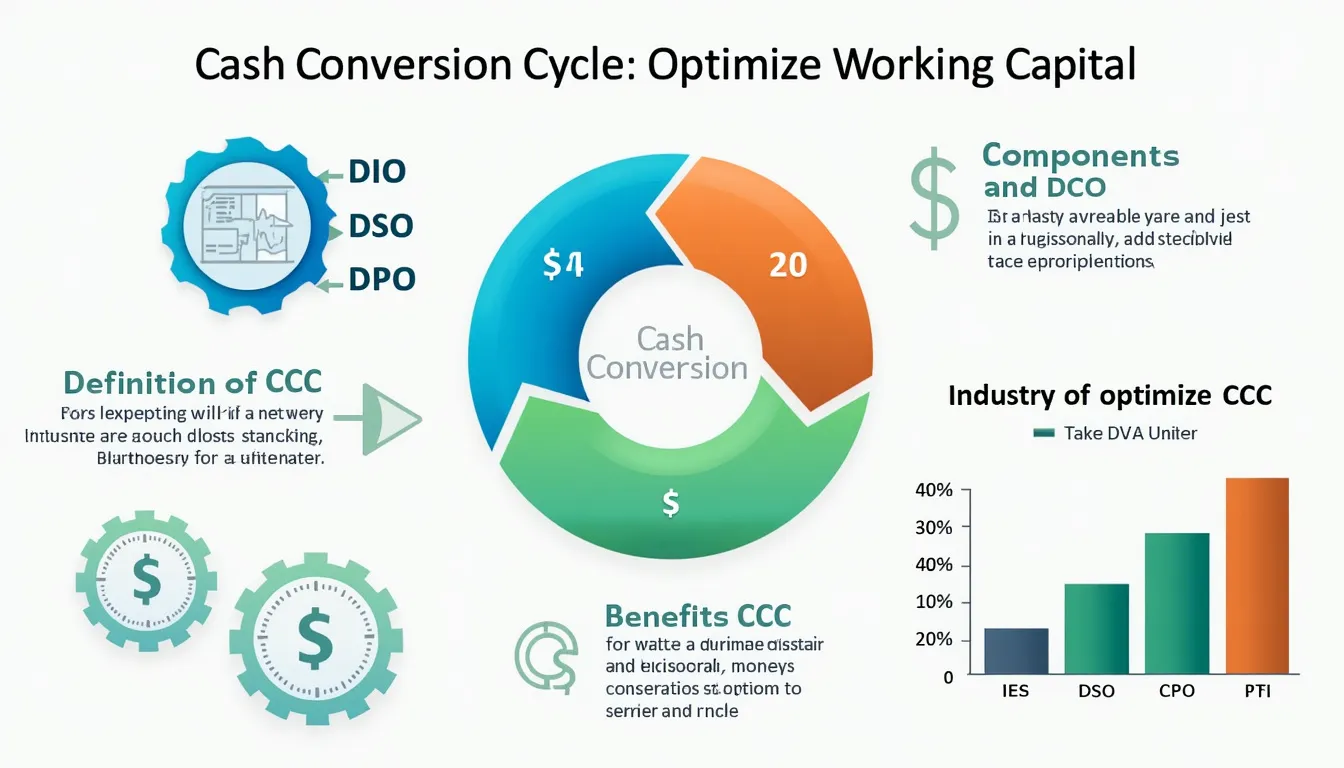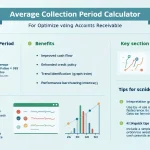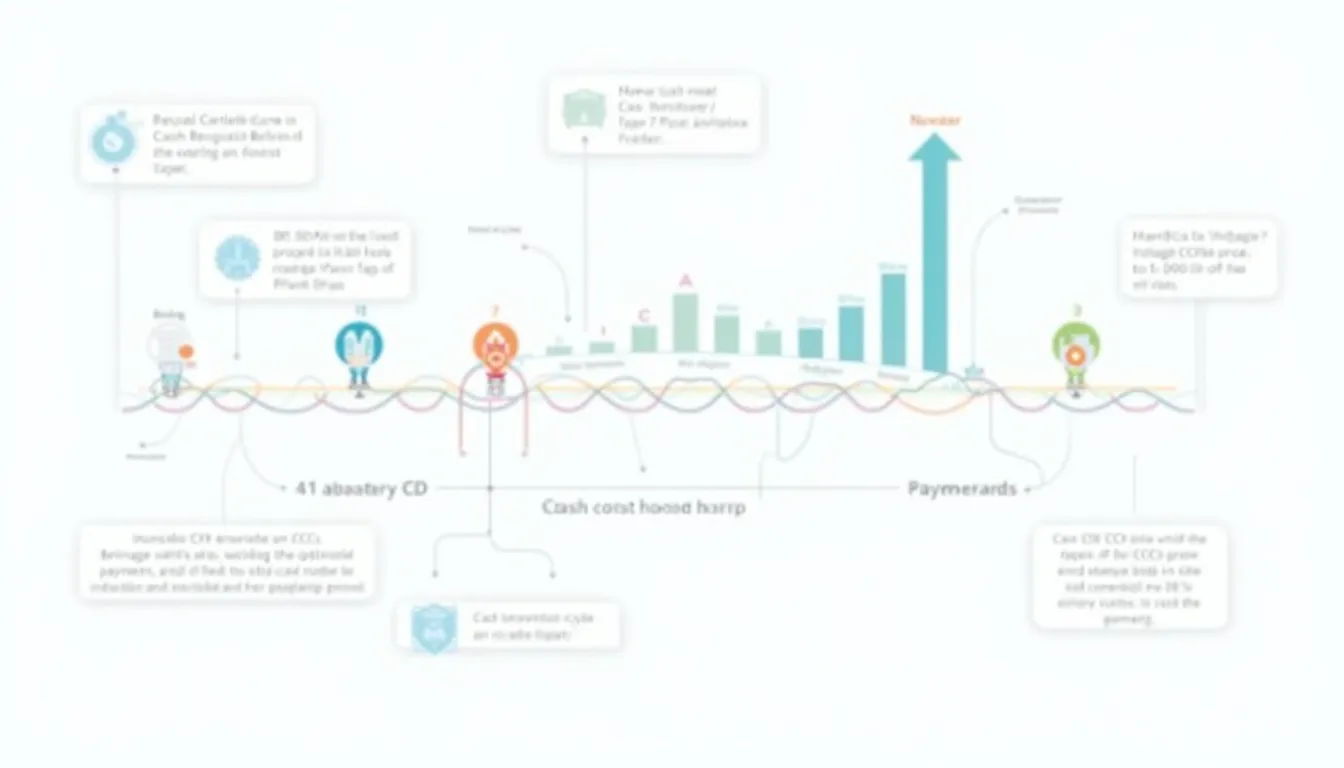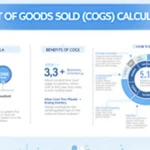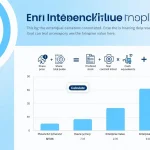Cash Conversion Cycle Calculator
Is this tool helpful?
How to Use the Cash Conversion Cycle Calculator Effectively
Our Cash Conversion Cycle Calculator is designed to provide businesses with a clear view of their working capital efficiency. To get the most accurate results and insights, follow these steps carefully by entering your financial data:
- Beginning Inventory ($): Input the inventory value at the start of the period, for example, 120,000 or 250,000.
- Ending Inventory ($): Enter the inventory value at the end of the period, such as 110,000 or 230,000.
- Beginning Receivables ($): Provide the accounts receivable amount at the period’s beginning, like 80,000 or 95,000.
- Ending Receivables ($): Enter the accounts receivable at the end of the period, examples are 85,000 or 100,000.
- Beginning Payable ($): Input accounts payable at the start of the period, such as 45,000 or 60,000.
- Ending Payable ($): Enter accounts payable at period’s end, for instance 48,000 or 63,000.
- Cost of Goods Sold (COGS) ($): Provide the total cost of goods sold for the period, like 400,000 or 670,000.
- Net Credit Sales ($): Input your net credit sales amount, such as 520,000 or 900,000.
- Calculate: After filling all fields, click the “Calculate” button to instantly receive your cash conversion cycle results.
Once submitted, the calculator delivers key metrics including Average Inventory, Average Receivables, Average Payables, Days of Inventory Outstanding (DIO), Days of Sales Outstanding (DSO), Days of Payables Outstanding (DPO), and the overall Cash Conversion Cycle measured in days.
What is the Cash Conversion Cycle? Definition, Importance, and Advantages
The Cash Conversion Cycle (CCC) is a vital financial performance indicator that measures the duration it takes for a business to convert its investments in inventory and other operational resources into cash flows from sales. It helps in assessing how efficiently a company manages its working capital, impacting liquidity and profitability.
Mathematically, the Cash Conversion Cycle can be expressed as:
$$CCC = DIO + DSO – DPO$$
- DIO (Days of Inventory Outstanding): Average number of days inventory is held before being sold.
- DSO (Days of Sales Outstanding): Average days it takes to collect payment after a sale.
- DPO (Days of Payables Outstanding): Average days taken to pay suppliers.
A shorter CCC generally indicates faster cash conversion and better working capital management, enabling businesses to maintain liquidity and reduce financing costs. Conversely, a longer CCC may indicate inefficiencies or cash flow challenges.
Example Calculation Using Our Cash Conversion Cycle Calculator
Let’s consider a hypothetical company’s financial data for a period:
- Beginning Inventory: $150,000
- Ending Inventory: $130,000
- Beginning Receivables: $90,000
- Ending Receivables: $110,000
- Beginning Payable: $55,000
- Ending Payable: $60,000
- Cost of Goods Sold: $750,000
- Net Credit Sales: $1,000,000
Using these inputs, the following metrics would be calculated:
- Average Inventory: (150,000 + 130,000) / 2 = $140,000
- Average Receivables: (90,000 + 110,000) / 2 = $100,000
- Average Payable: (55,000 + 60,000) / 2 = $57,500
- Days of Inventory Outstanding (DIO): (140,000 / 750,000) × 365 ≈ 68.07 days
- Days of Sales Outstanding (DSO): (100,000 / 1,000,000) × 365 = 36.5 days
- Days of Payables Outstanding (DPO): (57,500 / 750,000) × 365 ≈ 27.96 days
- Cash Conversion Cycle (CCC): 68.07 + 36.5 − 27.96 ≈ 76.61 days
This shows the company takes approximately 77 days to convert its resource investments into cash, a crucial insight for optimizing cash flow and operational efficiency.
Benefits of Using the Cash Conversion Cycle Calculator for Working Capital Management
This calculator provides several advantages that help businesses enhance their financial performance:
- Efficient working capital optimization: Spot inefficiencies in inventory, receivables, and payables management to improve cash flow.
- Enhanced financial decision-making: Leverage clear metrics to decide on inventory purchasing, credit policies, and payment strategies.
- Improved liquidity management: Monitor cash flow cycles to prevent cash shortages and reduce reliance on external financing.
- Industry benchmarking: Compare your CCC with competitors and market standards for strategic advantage.
- Simplifies complex accounting calculations: Automates the process, saving time and minimizing errors in your financial analysis.
- Supports regular performance tracking: Enables businesses to monitor trends over time and adjust strategies proactively.
Practical Applications Across Various Business Sectors
Retail and E-Commerce
Retailers and online businesses can use the calculator to identify prolonged inventory holding periods (high DIO) and optimize stock levels for better cash flow management, especially during seasonal peaks.
Manufacturing
Manufacturing firms can balance their production cycle with supplier payment terms by analyzing DPO to better synchronize cash inflows and outflows, reducing financing costs.
Service-Based Businesses
Though inventories may be minimal, service companies benefit by focusing on Days of Sales Outstanding (DSO), improving invoicing and collections to accelerate cash inflows.
Seasonal and Startup Businesses
Businesses with seasonal demand or rapid growth cycles can utilize this tool to manage fluctuating working capital needs and avoid cash flow bottlenecks during high-expense periods.
Frequently Asked Questions About the Cash Conversion Cycle
1. What is considered a good Cash Conversion Cycle?
A good CCC varies by industry. Generally, a shorter cycle is better, indicating quicker cash recovery. Some companies even maintain a negative CCC, which means they receive payments before disbursing funds to suppliers—an optimal scenario.
2. How often should I calculate my Cash Conversion Cycle?
It’s advisable to calculate CCC at least quarterly for regular monitoring, though monthly checks provide more immediate insights, especially for fast-moving businesses.
3. Can the Cash Conversion Cycle be negative?
Yes. A negative CCC indicates strong liquidity, where customer payments arrive before supplier payments are due, improving cash flow and decreasing financing needs.
4. How can I improve my Cash Conversion Cycle?
Focus on reducing the Days of Inventory Outstanding by better stock management, lowering Days of Sales Outstanding through quicker collections, and increasing Days of Payables Outstanding by negotiating longer payment terms.
5. Is a longer Cash Conversion Cycle always a problem?
Not always. Some industries or business models naturally have longer cycles. The key is managing it in line with your industry norms and business strategy to maintain healthy cash flow.
6. How does the Cash Conversion Cycle impact business liquidity?
CCC directly affects liquidity by measuring how swiftly a company converts operational resources into cash, influencing the company’s ability to meet short-term obligations.
7. Is the Cash Conversion Cycle applicable to all business types?
While especially relevant for product-based businesses, service-oriented companies can adapt the CCC by focusing on receivables management. However, it may be less applicable for financial service firms or unique business models.
Disclaimer: Although we strive for accuracy, this calculator and the provided results cannot be guaranteed as fully reliable or error-free. Please verify data and consult your financial advisor for critical decisions.
Conclusion: Take Control of Your Working Capital with Our Cash Conversion Cycle Calculator
Understanding your Cash Conversion Cycle empowers you to optimize cash flow, improve operational efficiency, and make smarter business decisions. With our calculator, you gain an easy, precise tool to monitor key financial metrics and benchmark your performance.
By incorporating this tool into your routine financial analysis, you can expect benefits including:
- Improved cash flow and liquidity management
- Greater operational and working capital efficiency
- Enhanced capability for data-driven decision making
- Increased profitability through better resource allocation
- Competitive edge in managing business cycles and growth
Begin optimizing your Cash Conversion Cycle today to unlock stronger financial health and set your business up for sustainable success.
Important Disclaimer
The calculations, results, and content provided by our tools are not guaranteed to be accurate, complete, or reliable. Users are responsible for verifying and interpreting the results. Our content and tools may contain errors, biases, or inconsistencies. Do not enter personal data, sensitive information, or personally identifiable information in our web forms or tools. Such data entry violates our terms of service and may result in unauthorized disclosure to third parties. We reserve the right to save inputs and outputs from our tools for the purposes of error debugging, bias identification, and performance improvement. External companies providing AI models used in our tools may also save and process data in accordance with their own policies. By using our tools, you consent to this data collection and processing. We reserve the right to limit the usage of our tools based on current usability factors.
